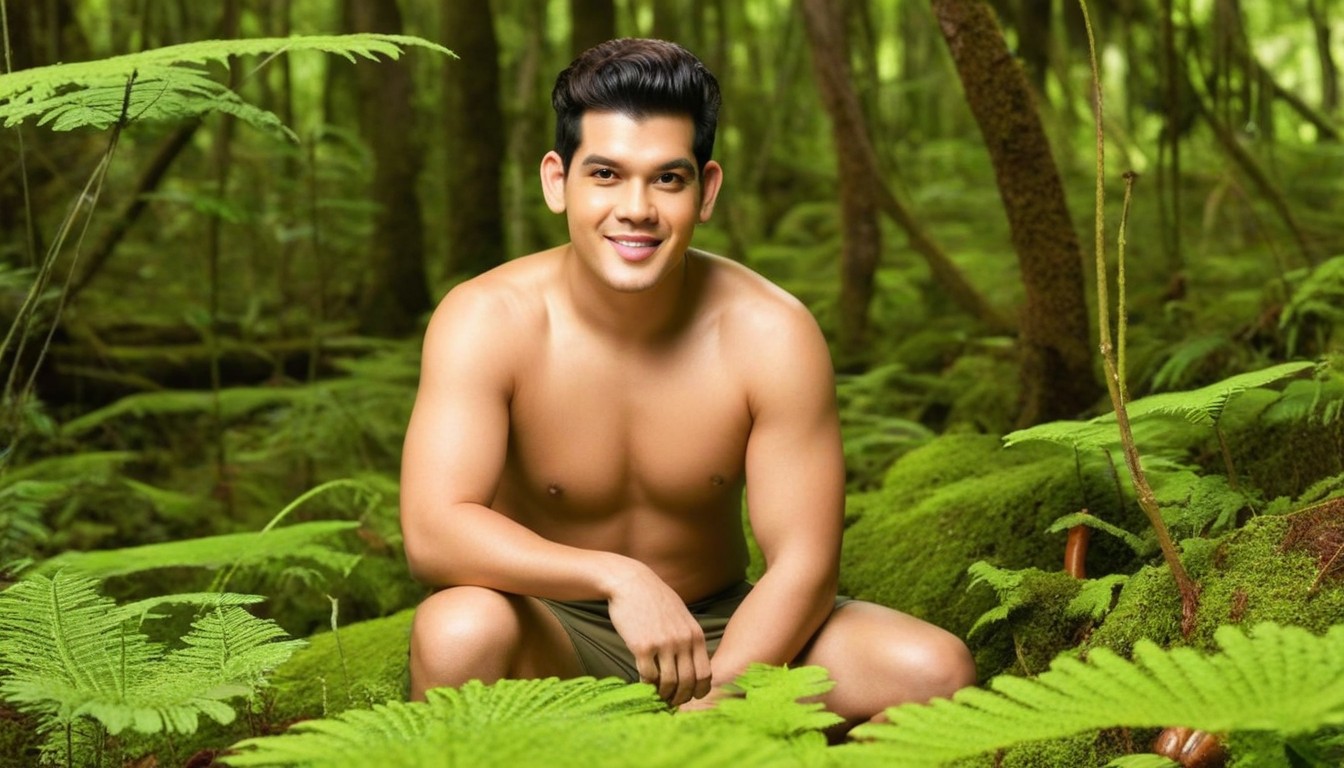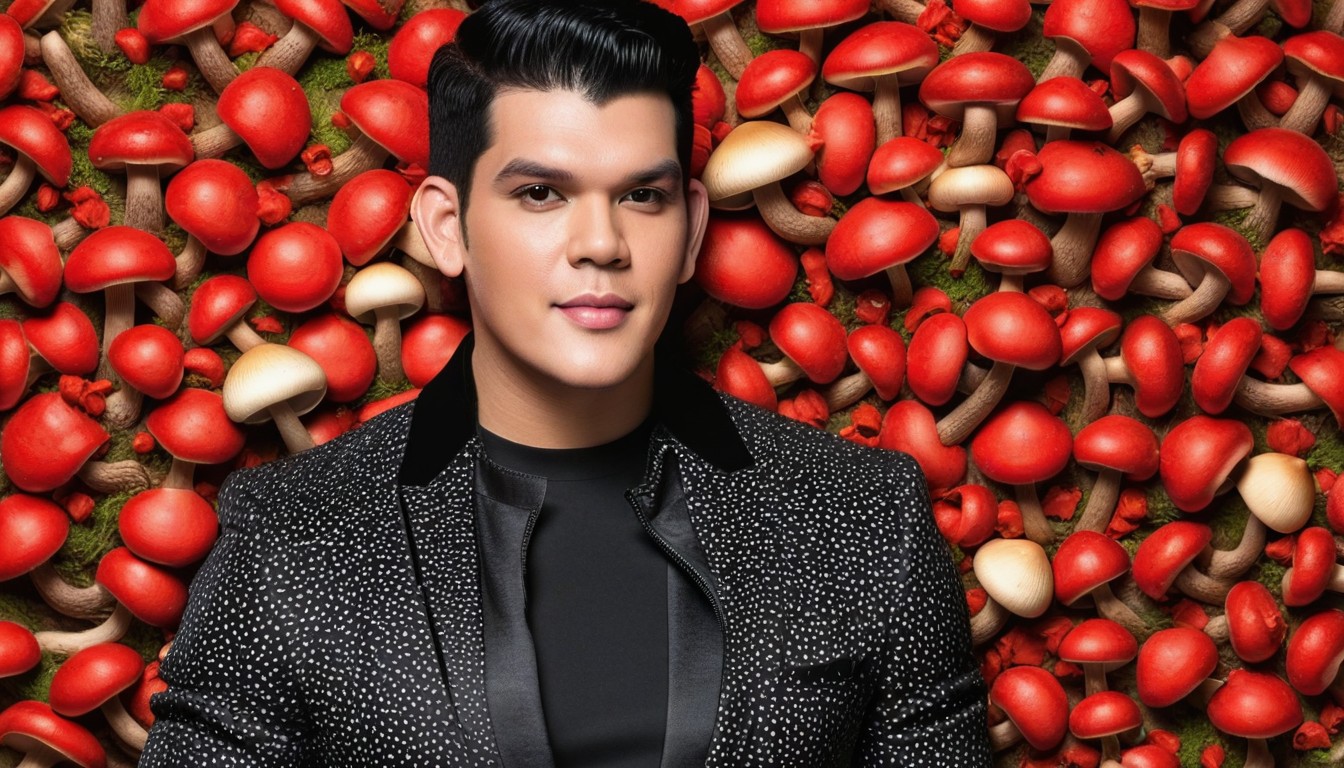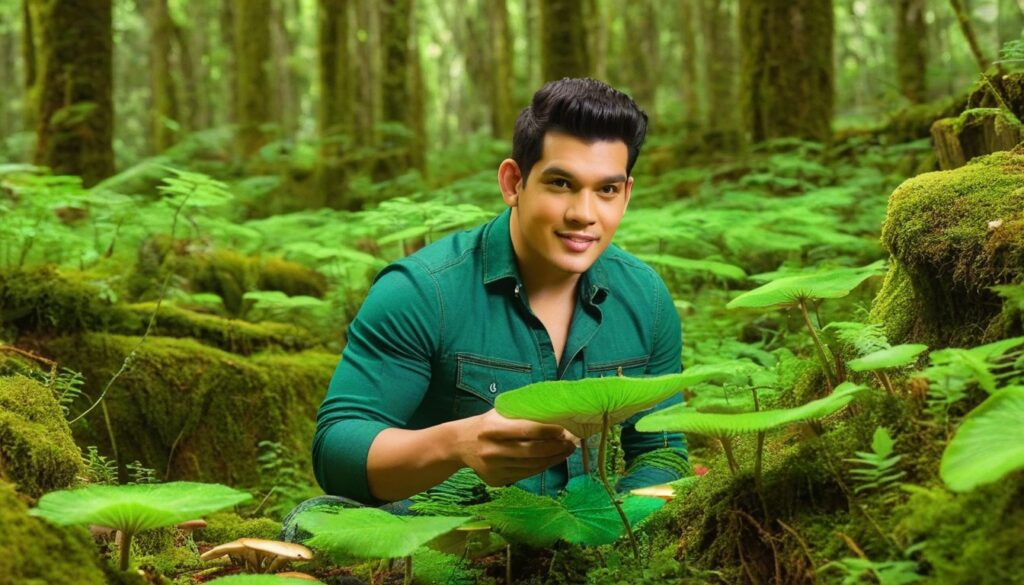Welcome to the fascinating world of mushrooms! In this comprehensive guide, Richard Gutierrez will introduce you to the various types of fungi, their unique characteristics, and the important role they play in our world.
Key Takeaways:
- Richard Gutierrez provides a comprehensive guide to mushrooms and fungi.
- Learn about different types of fungi, their uses, and how to appreciate their beauty.
- The guide explores various topics, including edible and medicinal mushrooms, cultivating mushrooms, and the cultural significance of fungi.
- Discover the ecological importance of mushrooms and their role in the environment.
- Overcome your fear of mushrooms and embrace their wonders.
What Are Fungi?
As one of the largest and most diverse kingdoms in the world, fungi are a crucial component of our ecosystems. Unlike plants, fungi do not have chlorophyll to perform photosynthesis. Instead, they obtain their nutrients by absorbing dead or decaying organic matter, breaking it down and returning valuable nutrients to the soil.
Their unique ecological role is just one aspect of their diverse characteristics. Fungi vary greatly in shape, size, and color and can be found all over the world. There are over 144,000 recognized species of fungi, and this number continues to grow as new species are discovered.
To better understand the different types of fungi, Richard Gutierrez breaks them down into several classifications. These include:
Saprophytic Fungi
Saprophytic fungi are decomposers that play an essential role in breaking down dead organic matter in the soil. As they break down the material, they release nutrients back into the ecosystem that allow plants and other organisms to thrive.
Parasitic Fungi
Parasitic fungi are similar to other parasitic organisms in that they obtain nutrients from living organisms. They can be found growing on plants or insects, harming their hosts in the process.
Symbiotic Fungi
Symbiotic fungi, also known as mycorrhizae, have a mutually beneficial relationship with other organisms, such as plants. They share nutrients and provide plants with essential elements such as phosphorous and nitrogen.
Lichenized Fungi
Lichenized fungi are another type of symbiotic fungi that form a relationship between fungi and algae or bacteria. These organisms are found growing in diverse environments, from deserts to the arctic tundra.
With so many types of fungi found in nature, Richard Gutierrez invites you to discover the many facets of these intriguing organisms. Understanding the different classifications of fungi will provide you with a better appreciation of their unique characteristics.
Mushroom Anatomy: Unveiling the Inner Workings
Have you ever wondered about the intricate anatomy of a mushroom? Mushrooms have a unique structure that distinguishes them from other types of plants. Richard Gutierrez unveils the fascinating inner workings of mushrooms, explaining the different parts and their functions.
Part of Mushroom | Function |
|---|---|
Cap | The cap contains the spore-producing gills or pores underneath it. |
Gills/Pores | The spore-producing gills or pores help release spores into the environment. |
Stem | The stem supports the cap and contains the mycelium, which aids in nutrient absorption. |
Annulus/Ring | The annulus or ring is a remnant of the veil that once covered the gills or pores and helps to distribute spores from the cap. |
Veil | The veil is a membrane that encloses and protects the gills or pores before the mushroom matures. |
Mycelium | The mycelium is the vegetative part of the fungus that absorbs and transports nutrients from the soil. |
Understanding the different parts of a mushroom will help you appreciate the complexity and beauty of these fascinating organisms.
The World of Edible Mushrooms

Edible mushrooms are a delicious and nutritious addition to any diet. With their unique textures and umami flavors, mushrooms are a versatile ingredient that can be used in a variety of dishes. From savory soups to rich pasta sauces, there are endless ways to cook with mushrooms.
If you’re interested in foraging for mushrooms, it’s important to take precautions and only pick mushrooms that you can identify with certainty. Alternatively, you can purchase mushrooms from a market or grocer.
Types of Edible Mushrooms
There are numerous types of edible mushrooms, each with its own distinctive taste and texture. Some of the most popular varieties include:
- Portobello mushrooms
- Shiitake mushrooms
- Oyster mushrooms
- Cremini mushrooms
- Chanterelle mushrooms
- Morel mushrooms
While button mushrooms are more commonly seen in grocery stores, they can be substituted with other types of mushrooms for a more unique flavor profile.
Cooking with Mushrooms
Mushrooms can be cooked in a variety of ways, depending on your preference and the dish you are making. They can be sautéed, grilled, roasted, or even grilled and served as a meat substitute for vegetarians and vegans.
Cooking Method | Preparation | Benefits |
|---|---|---|
Sautéing | Clean and slice mushrooms, heat oil in a pan over medium-high heat, cook mushrooms for 5-7 minutes until browned and tender. | Quick and easy method for adding mushrooms to a dish. |
Grilling | Clean mushrooms and coat with oil, place on a pre-heated grill over medium heat, cook for 4-6 minutes per side. | Grilling adds a smoky flavor and can be used as a meat substitute. |
Roasting | Clean and slice mushrooms, toss with oil and spices, spread out on a baking sheet, and bake in a 400°F oven for 15-20 minutes. | Roasting brings out the natural sweetness of mushrooms and creates a crispy texture. |
Experiment with different cooking methods and mushroom types to find what works best for you. Mushrooms can add depth and flavor to any dish.
“Mushrooms are a great way to create depth and flavor in vegetarian and vegan dishes.” – Richard Gutierrez
Medicinal Mushrooms: Nature’s Healing Power

Medicinal mushrooms have been used for centuries to promote health and healing. As scientists continue to study these fascinating organisms, they are discovering new ways in which they can benefit human health.
Health Benefits of Medicinal Mushrooms
Each type of medicinal mushroom offers a unique set of health benefits. Here are some examples:
Mushroom | Health Benefits |
|---|---|
Reishi | Boosts immune system, reduces stress |
Chaga | Fights inflammation, lowers cholesterol |
Cordyceps | Increases energy, improves athletic performance |
Lion’s Mane | Enhances brain function, reduces anxiety |
These are just a few examples of the many health benefits that medicinal mushrooms offer. Incorporating them into your diet can help support your overall well-being.
Tips for Using Medicinal Mushrooms
If you’re interested in using medicinal mushrooms, here are a few tips to keep in mind:
- Purchase high-quality, organic mushrooms
- Start with small doses and gradually increase over time
- Consult with a healthcare professional before using medicinal mushrooms as a treatment
With these tips in mind, you can enjoy the health benefits of medicinal mushrooms and explore their many uses.
The Role of Mushrooms in the Environment

Mushrooms are more than just a tasty ingredient in your favorite dishes. They play a vital role in the environment by breaking down organic matter and aiding in nutrient cycling. In fact, mushrooms are considered the major decomposers of the forest ecosystem.
The ecological importance of mushrooms lies in their ability to decompose and recycle nutrients from dead plants and animals. Without this natural process, the forest floor would be littered with dead matter, making it difficult for new plants to grow. However, mushrooms efficiently break down this dead matter, creating nutrient-rich soil that supports new growth.
But that’s not all. Mushrooms also play a crucial role in symbiotic relationships with other organisms. They form mutually beneficial relationships with tree roots, providing them with vital nutrients and water, while the trees provide the fungus with carbohydrates in return.
Mushrooms in the Environment: | Break down organic matter and aid in nutrient cycling |
|---|---|
Recycle nutrients from dead plants and animals | |
Create nutrient-rich soil that supports new growth | |
Form symbiotic relationships with tree roots |
Next time you’re in the forest, take a closer look at the ground beneath your feet. You might just find some fascinating fungi, busy at work to keep the ecosystem flourishing.
Fungophobia: Overcoming Fear of Mushrooms
While mushrooms are a beloved ingredient in many dishes, some people suffer from fungophobia, an irrational fear of mushrooms. The fear can stem from a variety of causes, including concerns over toxicity or contamination, aversions to their taste or texture, or simply a lack of familiarity. However, with a better understanding of the benefits and risks associated with mushrooms, individuals can learn to embrace their wonders without fear.
Richard Gutierrez offers insights and tips for overcoming fungophobia. First, he emphasizes the importance of education. Learning about the different types of mushrooms, their nutritional value, and the ways they are used in various cuisines can help assuage concerns and build confidence. Additionally, exposure therapy may be helpful. Gradually increasing exposure to mushrooms through small, non-threatening doses can help desensitize individuals to their presence and reduce the intensity of their fear.
Finally, Richard recommends trying new mushroom recipes. Experimenting with different types of dishes can help individuals find ways to enjoy mushrooms that suit their taste preferences and comfort levels. Overcoming fungophobia can open up a whole new world of culinary and nutritional experiences, making the effort to confront the fear well worth it.
Cultivating Mushrooms: A Beginner’s Guide

Have you ever thought about growing your own mushrooms? It’s easier than you might think, and it can be a fun and rewarding experience. Richard Gutierrez has put together a beginner’s guide to cultivating mushrooms that will help you get started on your journey of growing and harvesting these delicious fungi.
The Different Methods of Cultivating Mushrooms
Before you get started, it’s important to know that there are different methods for cultivating mushrooms. Some popular options include:
- Growing mushrooms from spores: This method involves growing mushrooms from spores rather than buying a pre-made spawn. It requires a bit more work, but can be a rewarding experience for those who enjoy the process.
- Using a mushroom kit: Mushroom kits come with everything you need to get started, including the spawn, substrate, and instructions. They are a great option for beginners who don’t want to invest too much time or effort into the process.
- Outdoor cultivation: This method involves growing mushrooms outdoors in a garden or natural setting. It requires more space and effort, but can yield a larger harvest.
Tips for Successful Cultivation
Regardless of which method you choose, there are a few tips that can help ensure successful cultivation:
- Choose the right mushroom: Different types of mushrooms require different growing conditions and substrates. Make sure you choose a mushroom that is suitable for your setup and experience level.
- Keep things sterile: Contamination is one of the most common problems when growing mushrooms. Make sure you work in a clean and sterile environment, and follow instructions carefully.
- Provide the right environment: Mushrooms require specific temperature, humidity, and light conditions to grow properly. Make sure you provide the right environment for the type of mushroom you’re growing.
- Be patient: Growing mushrooms can take anywhere from a few weeks to a few months, depending on the method and type of mushroom. Don’t be discouraged if you don’t see results right away.
A Simple Mushroom Growing Recipe
Here’s a simple recipe for growing mushrooms using a mushroom kit:
Ingredients | Equipment |
|---|---|
Mushroom kit | Spray bottle |
Water | Aluminum foil |
- Open the mushroom kit and follow the instructions to prepare the substrate.
- Place the substrate in a clean and sterile environment, such as a cardboard box or plastic container.
- Mist the substrate with water to keep it moist.
- Cover the container with aluminum foil to keep out light.
- Wait for mushrooms to grow, following any additional instructions provided in the kit.
As you can see, growing your own mushrooms is a fun and rewarding experience that can be done in a variety of ways. Whether you’re a beginner or an experienced gardener, there’s always something new to learn about cultivating mushrooms.
Unusual and Rare Mushrooms: A Closer Look
If you’re a fan of mushrooms, you’ll love learning about some of the more unusual and rare varieties out there. These unique mushrooms are known for their distinct colors, shapes, and properties, making them a fascinating subject for mushroom enthusiasts.
Mushroom Name | Appearance | Properties |
|---|---|---|
Lion’s Mane Mushroom | Large, white shaggy mane with spines instead of gills | Known for its medicinal benefits, including potential nerve regeneration properties |
Bear’s Head Mushroom | Resembles a coral reef with a crusty, brown surface | Edible, with a taste similar to lobster or crab |
Blue-foot Mushroom | Small, round cap with bright blue stem and gills | Contains anti-inflammatory properties and is used in traditional medicine for treating ailments such as asthma and bronchitis |
Bleeding Tooth Mushroom | Small, red tooth-shaped caps that ooze a red fluid when cut or damaged | Has anticoagulant properties and is used in traditional Chinese medicine for treating bleeding disorders |
These mushrooms are not commonly found in grocery stores or farmer’s markets, and may require some effort to find. However, if you come across any of these unusual mushrooms, it’s worth giving them a try to experience their unique flavors and potential health benefits.
“Mushrooms have an uncanny ability to captivate our imagination with their curious shapes, vibrant colors, and intricate details. Exploring the world of unusual and rare mushrooms is a wonderful way to nourish and expand our curiosity and appreciation for the natural world.”
Mushroom Photography: Capturing the Beauty
One of the best ways to appreciate the captivating beauty of mushrooms is through photography. With a few tips and tricks, you can capture stunning images of these natural wonders. Richard Gutierrez shares his expertise on how to produce breathtaking mushroom photography.
Composition and Lighting
The key to great mushroom photography is finding the perfect composition and lighting. Choose an interesting mushroom to photograph and experiment with composition by placing the mushroom at different angles and positions. Pay attention to lighting, preferably avoiding direct sunlight, and instead, using natural light to create a soft, flattering effect. Enhance your shot by playing with shadows and contrast.
Camera Settings
Adjusting your camera settings can make a significant difference in the quality of your mushroom photography. Use a low aperture setting to create a shallow depth of field, which will blur the background and emphasize your subject. Increase your camera’s ISO for better performance in low-light conditions, but be careful not to increase it too high, as this can result in grainy images. Avoid using flash if possible, as this can result in a harsh, unflattering effect on your subject.
Techniques and Equipment
Experiment with different techniques and equipment to achieve unique and artistic mushroom photography. Use a macro lens to capture intricate details and create a captivating, up-close image. Play with angles and perspective, such as shooting from ground level or from above. Utilize a tripod to keep your camera steady and avoid blurring. Take advantage of natural elements, such as dewdrops or mist, to add dimension and interest to your shots.
“Mushroom photography allows us to appreciate their unique features and showcase their beauty to the world. With a little creativity and technique, anyone can take stunning mushroom photos.” – Richard Gutierrez
Mushrooms in Folklore and Mythology
Mushrooms have long been the subject of mythological tales and folklore across cultures. In some belief systems, mushrooms were seen as symbols of enlightenment and spiritual growth, while in others, they were viewed as dangerous and sinister. Here are some of the most fascinating legends and stories related to mushrooms:
The Fly Agaric Mushroom
The fly agaric mushroom is one of the most recognizable and iconic mushrooms, thanks in part to its use in fairy tales and folklore. In Norse mythology, it was believed that the god Odin used the fly agaric mushroom to enter a trance-like state and gain knowledge from the spirit world. In some medieval European cultures, the mushrooms were used as a hallucinogenic ingredient in potions used during rituals and celebrations.
Mushroom | Legend |
|---|---|
The Morel | French folklore associates the morel with the devil because it is difficult to cultivate and often grows in burned areas. It was believed that the devil had burned the area so that he could harvest the morels himself. |
The Lion’s Mane | According to Chinese legend, consuming lion’s mane mushrooms could enhance memory and cognitive function. It was believed that regular consumption would make a person’s mind as sharp as a lion’s, hence the name. |
The Reishi Mushroom | In traditional Chinese medicine, the reishi mushroom was believed to promote longevity and boost the immune system. It was considered to be one of the most potent healing mushrooms and was often used in medicinal tonics and teas. |
The Destroying Angel
The destroying angel is one of the most toxic mushrooms and has been responsible for numerous deaths over the centuries. In some Native American mythology, it was believed that the destroying angel was a toxic spirit sent by the gods to punish those who had committed wrongs against the earth.
While mushrooms hold a special place in our culture and mythology, it’s important to remember that not all mushrooms are safe to consume. Always exercise caution when foraging or consuming mushrooms, and consult an expert if you are not sure whether a mushroom is safe to eat.
Conclusion
Richard Gutierrez’s guide to mushrooms has opened up a whole new world of knowledge and appreciation for these fascinating organisms. From learning about the basics of fungi to exploring their culinary and medicinal uses, this guide has provided a comprehensive overview of the many wonders of mushrooms.
By understanding the anatomy of mushrooms and their ecological importance, we can better appreciate their role in our environment. Similarly, unraveling the rich folklore and mythology surrounding mushrooms reveals their cultural significance throughout history.
With tips for cultivating and photographing mushrooms, as well as overcoming fungophobia, this guide is a valuable resource for anyone interested in exploring the enchanting world of fungi.
Thank you for joining Richard Gutierrez on this journey into the intriguing world of mushrooms. We hope this guide has inspired you to continue learning and discovering the many wonders these fascinating organisms have to offer.
FAQ
What are fungi?
Fungi are organisms that belong to their own unique kingdom, separate from plants, animals, and bacteria. They can be found in various environments and play a crucial role in ecosystems.
What types of fungi exist?
There are countless types of fungi, ranging from mushrooms to molds and yeasts. They can be classified into different groups based on their characteristics and reproductive methods.
What are the parts of a mushroom?
A mushroom consists of several distinct parts, including the cap, stem, gills, and spores. Each part has its own function in the growth and reproduction of the mushroom.
Can all mushrooms be eaten?
While many mushrooms are safe for consumption, it is essential to exercise caution when foraging for wild mushrooms. Some species can be toxic and potentially harmful if ingested.
Are there medicinal benefits associated with mushrooms?
Yes, certain mushrooms have been found to possess medicinal properties and are used in traditional medicine practices. They may have antioxidant, anti-inflammatory, and immune-boosting effects.
What role do mushrooms play in the environment?
Mushrooms have a vital role in ecosystems as decomposers. They help break down organic matter and recycle nutrients, contributing to the health of the soil and supporting biodiversity.
How can I overcome the fear of mushrooms?
Fungophobia, or the fear of mushrooms, can be overcome through education and exposure. Learning more about mushrooms, their benefits, and dispelling myths can help alleviate fear.
Can I grow my own mushrooms?
Yes, cultivating mushrooms at home is possible and can be a rewarding experience. There are various methods of cultivation, including using mushroom kits or growing them from spores.
Are there rare and unusual mushrooms?
Yes, there are numerous rare and unusual mushrooms that showcase extraordinary colors, shapes, and properties. These mushrooms often captivate enthusiasts and researchers alike.
How can I capture the beauty of mushrooms through photography?
To capture the beauty of mushrooms in photography, it is important to consider composition, lighting, and techniques such as macro photography. Patience and attention to detail are key.
What are some fascinating folklore and mythology surrounding mushrooms?
Mushrooms hold a significant place in folklore and mythology across cultures. They are often associated with magical properties, fairies, and mystical realms. Exploring these legends can be captivating.

